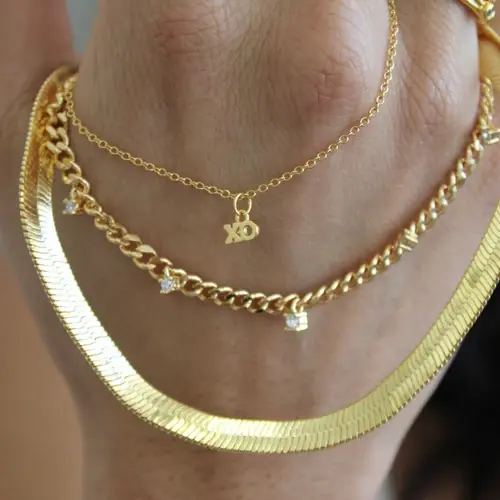Gold jewelry is a timeless staple in any wardrobe, but distinguishing between different types can be tricky. Understanding the differences between 14-karat gold and 18-k gold-plated jewelry can help you make informed purchasing decisions and ensure you’re investing in pieces that best suit your style and budget.
1. Understanding Karat Measurements
Karat is a term used to describe the purity of gold. The higher the karat number, the more gold content is present in the piece. Understanding karat measurements is essential to navigating the world of gold jewelry.
A crucial aspect of karat measurements is the numerical representation of gold purity. For instance, 24-karat gold is considered pure gold, translating to 99.9% gold content. However, pure gold is often too soft for practical jewelry use, which is why it’s mixed with other metals like copper and silver to create more durable alloys. These mixtures result in karats less than 24, like 14 and 18, offering a balance between beauty and strength. By familiarizing yourself with karat measurements, you can make well-informed decisions that align with your preferences and lifestyle needs.
2. What Makes 14 Karat Gold Special?
Consisting of 58.3% pure gold, 14-karat gold is celebrated for its perfect combination of durability and luster. It’s a popular choice for everyday jewelry due to its resistance to wear and affordability.
14-karat gold strikes an admirable balance many jewelry lovers seek. Its alloy, comprised of gold and a significant percentage of metal like nickel or zinc, provides enhanced hardness ideal for rings, bracelets, and necklaces intended for daily wear. This sturdiness makes it less prone to scratches and dents, allowing wearers to enjoy their jewelry without the constant worry of damage. Plus, the warm, classic tone of 14-karat gold complements diverse fashion styles, making it a versatile choice. Because of these attributes, 14-karat gold has become a mainstay in personal jewelry collections across the globe.
3. Decoding 18K Gold-Plated Jewelry
Unlike solid gold, 18K gold-plated jewelry features a thin layer of gold over a base metal. While it offers the allure of high-karat gold, it comes at a fraction of the price, making it an attractive option for those on a budget.
18K gold-plated jewelry captivates the imagination by mimicking high-end luxury. This kind of jewelry gives off a splendid, rich color characteristic of solid 18-karat gold pieces while being significantly more affordable. The process involves electronically bonding a tiny layer of gold onto a piece of metal, typically made from brass or copper. These pieces can appear closely akin to their solid counterparts in appearance, allowing fashion enthusiasts to access golden opulence without the hefty price tag. Nevertheless, due to the nature of the gold plating, these items require gentle care to prevent the gold layer from wearing off, ensuring they retain their gleam for longer periods.
4. Comparing Durability and Longevity
Solid gold pieces, like 14-karat gold, can endure daily wear and tear better than gold-plated options. Learn why 14-karat gold is favored for its resilience and how it compares to the more delicate nature of gold-plated jewelry.
Durability is a significant factor that distinguishes 14-karat gold from 18K gold-plated jewelry. While both exhibit an eye-catching shine, solid gold’s robustness means it can withstand the rigors of daily activities better than its plated counterpart. Gold-plated jewelry, despite having that appealing gold veneer, is prone to fading and requires careful handling. Frequent exposure to water, chemicals, or rough wear can accelerate this process, revealing the base metal underneath. In contrast, 14-karat jewelry’s enduring nature makes it a long-term companion, maintaining its beauty through the years and providing peace of mind over time.
5. Price Considerations and Investment Value
While 18K gold-plated jewelry is initially less expensive, understanding the long-term value difference with 14 karat gold is vital. Consider the factors that contribute to cost differences and their implications for investment.
Investing in gold jewelry often involves weighing immediate costs against long-term benefits. Though 18K gold-plated pieces are budget-friendly, they lack in value accumulation over time. Solid gold, particularly in the form of 14 karat, has intrinsic value due to its gold content, exhibiting prospects of financial return when the market favors gold. Whether considering a piece for personal indulgence or future resale, recognizing the greater resilience and market stability of 14-karat gold contributes greatly to it being a financially savvy choice. The decision ultimately reflects personal priorities, whether focusing on current affordability or potential investment returns.
The Influence of Coastal Style on Modern Jewelry Design
The Power of Accessories: Transform Your Look with Simple Additions
How to Choose the Right Metal for Your Jewelry: Gold, Silver, and More
From Studs to Statements: Choosing the Perfect Earrings for Your Face Shape





















